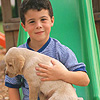At St. Louis Children’s Hospital and Washington University School of Medicine, we are pleased to offer multidisciplinary services aimed at treating brachial plexus injuries affecting infants and children. We represent multiple specialties, including Pediatric Plastic and Reconstructive Surgery, Physical Therapy, Occupational Therapy, Orthopedic surgery, Pediatric Neuroradiology, Pediatric Neurology, Physical Therapy, Social Work, Pediatric Plastic and Reconstructive Surgery Nursing Specialists and Anesthesiology / Pain Management.
We specialize in treating both infants and older children with brachial plexus injuries and treat children from all over the country.
About the Brachial Plexus Palsy Clinic
Sometimes the birth process leads to trauma to the nerves that provide movement to the arm. This condition is usually called obstetrical brachial plexus palsy (OBPP). Other names for it include neonatal brachial plexus palsy, perinatal brachial plexus palsy, birth brachial plexus palsy, infant brachial plexus palsy, newborn brachial plexus injury, neonatal brachial plexus injury, birth-related brachial plexus palsy, and congenital brachial plexus palsy.
Treatment Timeline...
Newborn to two weeks:
Specialized exercises begin with occupational and physical therapists.
One month:
Seen by therapists and surgeon in our multidisciplinary brachial plexus clinic. Additional exercises begin. In rare, severe cases, surgery may be recommended as early as one month of age.
Three months:
Surgical evaluation using the Toronto Test Score.
Three to five months:
Isolated selective nerve transfers, if needed for improvement.
In some cases, surgery is performed at age six months or as late as nine months, depending on the degree of movement in the arm and the particular needs of the child. Although most children do not need surgery, it is important to operate on children that can show improvement.
Surgical Treatment: what to expect
- Prior to the operation, either an MRI or a CT myelogram and a diaphragm ultrasound are done to guide our management. Electrical studies (EMG) are not necessary for infants.
- The operations usually take between 5 and 10 hours.
- The infants typically stay in the hospital for two days. Families who live far away should plan to stay in St. Louis for several days for follow-up visits.
- The child’s arm is placed in a soft sling for about three weeks after the operation. Usually range of motion therapy can be continued for the wrist, fingers and thumb during this time.
- At three weeks after surgery, range of motion therapy for the elbow and shoulder can begin again.
The results of surgery are seen usually within four to six months. Recovery continues until around age three or four, at which point the results can be considered more or less “final” from a nerve recovery standpoint. If there are other improvements that would benefit the child, such as limitations of shoulder, elbow or wrist motion, then we may advise parents to consider additional operations.
We continue to follow all of our patients into adulthood. Sometimes, as children grow older, other issues may arise. They may want to participate in activities that require additional movements that can be improved with therapy or surgery. Occasionally pain is an issue with older children – and this may be treatable.
Treatment for Older Children
 In the case of an older child with a brachial plexus injury, from a gunshot wound, motor vehicle accident or other injury, it’s important to see them as early as possible after injury. Lung, brain or spinal cord injuries may require stabilization at the referring hospital prior to transfer. A detailed examination of the sensory and motor function of the arm is performed. Depending on the level and nature of the injury, nerve grafting or nerve transfers may help in improving recovery.
In the case of an older child with a brachial plexus injury, from a gunshot wound, motor vehicle accident or other injury, it’s important to see them as early as possible after injury. Lung, brain or spinal cord injuries may require stabilization at the referring hospital prior to transfer. A detailed examination of the sensory and motor function of the arm is performed. Depending on the level and nature of the injury, nerve grafting or nerve transfers may help in improving recovery.
Usually in cases of closed injury (such as car crashes), we would not perform surgery until three months after the injury. In these cases, electrical studies (EMG) can be quite helpful, as well as MRI, CT and diaphragm ultrasound. If there is an open injury then surgical exploration and nerve grafting with or without nerve transfers may be warranted before three months.
Surgery for older children: what to expect
- These operations usually take about five to eight hours -- or more -- to complete.
- Hospitalization is typically two days or longer in especially complex cases.
- Depending on the type of operation, a soft sling or a splint may be applied.
- Range of motion therapy is very important before and after the operation and improvement continues for about two or three years after the operation.
- In cases of severe injury, muscle transplants, combined with nerve transfers, may provide the best outcome. In these cases, we use the gracilis muscle (a long, thin “extra” muscle from the inner thigh).
Pain from such injuries can sometimes be significant. When appropriate, surgery and/or certain medications can sometimes improve the pain. Pain specialists are available to assist with pain management.
Pain Management
Pain control begins at the first visit. This is a very important issue. For infants, we take care to accomplish therapy exercises with a minimal amount of discomfort. After surgery, infants receive pain medication through an IV and by mouth. At discharge, patients receive prescriptions for narcotic pain medication, but often parents do not need to give anything stronger than Tylenol after a few days.
As the children grow up, pain is usually not an issue. However, if pain continues, we try to determine if there is a surgical way to improve the pain or if medications can help in reducing discomfort.
In older children with traumatic brachial plexus injuries, such as car crashes, pain can sometimes be a major issue. In these cases, we often begin medications to help minimize the discomfort and then refer to our pain specialists in the Department of Anesthesiology.
Meet the Doctors
Frequently Asked Questions...
Will my child’s arm and hand work normally?
Most children with obstetrical brachial plexus palsy do not need surgery. The majority have very functional arms and hands. However, about 20-25% would benefit from an operation. In these cases, we are trying to address a more serious nerve injury. Often we are able to make significant improvements in strength and range of motion. Most children go on to lead very normal lives, participating in regular school activities, and sports. For older children with traumatic injuries, treatment varies widely.
How many surgeries are needed?
Although most children do not need surgery for obstetrical brachial plexus palsy, there may be a need for additional operations later in life to improve movement of the shoulder or elbow. Or, if there is tightness in certain muscles, we may recommend using locally deposited medications to relax the tight muscles so that opposing muscles may function better. For children with traumatic nerve injuries, we usually try to perform nerve reconstruction as the initial operation. Then, if there are other problems that need to be addressed, we can often perform muscle or tendon transfers, and sometimes other nerve operations to improve function.
How long does it take to see the results of surgery?
It will take several months for the nerves to regenerate, since they grow at less than one millimeter per day (less than the thickness of a dime). Then progress will usually continue for years. Results are usually considered stable, from a nerve standpoint, about three years after surgery.
What if we are from out of town?
St. Louis Children’s Hospital allows and encourages one parent to stay in the same room as the child. For clinic visits, there are a number of nearby hotels. For help with accommodations please call Guest Services at 314.454.2615.
Can you use a parent’s nerves or muscles?
We do not recommend this approach since the child would have to be on transplant medicines that can be toxic when used long term.
What about scarring?
Depending on the type of operation needed, there will be small permanent scars on the legs from removing nerves for grafting. There may be a scar over the arm, on the neck or collarbone, or on the back. These scars usually heal very well. If there are concerns, different therapies and topical agents are available.












